This website is supported by its readers. If you click one of my links I may earn a commission. I am also a participant in the Amazon affiliates program and I will also earn a commission from qualified purchases.
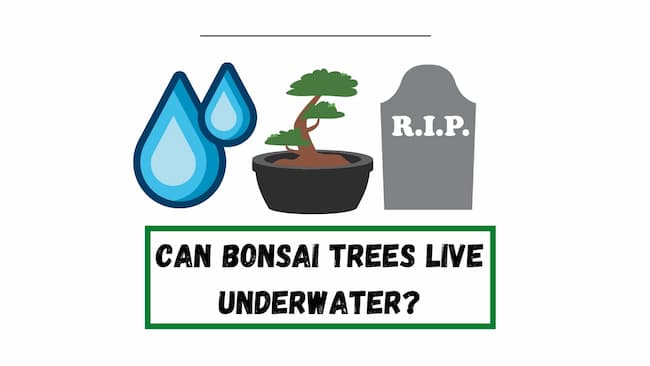
Bonsai trees are one of the most common garden hobbies. Most species, such as Chinese Elm or Ficus, are straightforward to care for and add greenery to your home. It is, however, becoming increasingly popular to move bonsai trees away from traditional indoor spaces and place them underwater. So can bonsai trees live underwater?
Bonsai trees cannot live or be grown underwater. Their roots will become waterlogged, the tree will not be able to absorb adequate sunlight, and the stomata will fail to absorb CO2 – in turn, killing the tree.
However, it is possible to grow a bonsai tree underwater by submerging its roots underwater instead of in a soil pot, better known as hydroponic growing or aqua bonsai.
So are there any species that will benefit from being grown underwater? And how can you add a bonsai to an aquarium without killing your tree? Keep reading to find out more!
Just a quick heads up, over the past three years of running Plantpaladin, hundreds of people have asked for product recommendations. As such, You can find my favorite indoor bonsai tree here (link takes you to Bonsaiboy), my favorite outdoor bonsai tree (link takes you to Bonsaiboy), or have a look at all the products I recommend here.
Can bonsai trees live underwater?
So before you get overexcited and decide to dunk your bonsai tree in your aquarium, pond, or underwater space, it’s essential to know if it’s possible to grow your bonsai tree underwater.
To get to the bottom of this then, I got in touch with 20 plant paladin readers who I surveyed and visited my local botanical gardens.
To summarize:
- Simply taking your existing bonsai tree from its pot and placing underwater in a fishbowl or underwater space is not recommended.
- If you submerge an existing live bonsai underwater for prolonged periods, typically more than a few days, it will die.
- This is because bonsai trees ingest carbon dioxide and other gasses from the stomata in the leaves of the tree, as well as vital nutrients from the soil they are kept in.
- Placing them in an underwater aquarium space will suffocate or drown the tree preventing it from gaining these vital nutrients and gasses.
- Even temporarily placing your entire bonsai tree underwater can cause your tree to become over-watered and waterlogged resulting in fungal infections such as root rot.
- Bonsai trees, however, can be grown underwater should only their roots be submerged through a process called hydroponic growing, where vital nutrients are added to the small pool of water in which you will keep the bonsai tree.
- These are better known as Aqua bonsai trees and are proving increasingly popular in the home aquarium space.
- Most bonsai trees kept in underwater aquariums are driftwood transformed to look like an underwater bonsai.
Now, this is a fair bit of information, so let’s dive into more detail about bonsai trees being underwater.
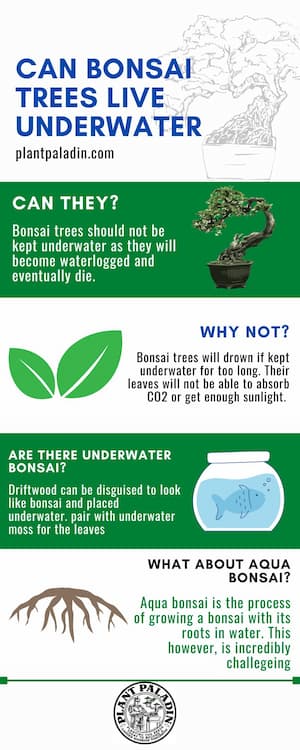
Why can’t bonsai trees live underwater?
So why can’t bonsai trees live underwater? Especially as you see these so commonplace in aquariums.
Well, bonsai trees are meant to be grown in nutrient-rich soil and surrounded by air full of carbon dioxide that they absorb through the stomata on the leaves.
If you were to take your existing bonsai, such as a Ficus, remove it from its pot, and place it underwater, the tree would start to suffer.
First, it would have a massive abundance of water.
Most bonsai trees need to be watered about once to twice weekly when the topsoil is dry.
By placing them underwater, the roots and leaves will have abundant water, causing the tree to become waterlogged.
This will cause significant root rot and fungal infections in the tree.
You must dry off your bonsai and remove some roots to prevent the rot from spreading.
On top of this, bonsai trees absorb light and carbon dioxide from the stomata in the leaves.
Submerging the tree underwater will limit the amount of carbon dioxide it can pull from the oxygen-rich water of aquariums, which will cause the leaves to fall off or yellow eventually.
Finally, like all trees, bonsai trees need sunlight to photosynthesize accurately.
While many aquariums have LED lights, the quality of the light tends to get diluted in the water, which is seldom enough for bonsai trees.
How do people keep bonsai underwater?
I know what you’re thinking if moving your bonsai tree underwater will drown the tree, how do so many people have bonsai trees in their fish tanks?
People use two main methods to grow bonsai trees underwater or in aquariums.
- Through bonsai driftwood
- Through Hydroponic growing also commonly referred to as aqua bonsai)
Bonsai driftwood vs. Hydroponic growing
So what exactly is the difference between bonsai driftwood and Hydroponic growing (aqua bonsai)?
After all, if you can use both methods for growing bonsai trees underwater, how will you know which is better?
Let’s explore the two options further.
Bonsai driftwood
Bonsai driftwood is the most common method of growing” bonsai trees” underwater.
I put bonsai trees in quotes because it is an illusion.
Bonsai driftwood is pieces of driftwood found from ponds and rivers or purchased online that are whittled down or glued together with other driftwood to give the illusion of bonsai trees.
Underwater plants and mosses are then attached to the driftwood to give the illusion of a bonsai tree.
These trees are more sculptured than actual trees, have no roots, do not need care, and can be left alone in your aquarium or underwater space.
Hydroponic growing (Aqua bonsai)
The other primary method that people use to grow bonsai trees in their underwater spaces is hydroponic growing.
Instead of the entire bonsai tree being submerged underwater, it is mainly the tree roots that are grown underwater.
Hydroponic growing for bonsai trees will typically work best for small-sized bonsai trees.
Around 250ml then of water is put into a clear container.
A bonsai tree is placed in the water, and two drops of fertilizer are added to the water solution.
However, this will only typically work well for smaller-sized bonsai trees, so more giant bonsai trees may need help getting a foothold in larger aquariums if your goal is to have a bonsai tree in a fish tank.
How long can bonsai trees survive underwater?
Bonsai trees should be kept underwater for up to three days. Doing so any longer will cause root rot, fungal infections, and an overwatered tree that you may be unable to recover.
Bonsai trees grown through hydroponic growing – also known as aqua bonsai, can live with their roots submerged for the duration of their life.
This is so long as they are kept in a bright spot with plenty of sunlight, regular fertilizing once weekly, and water change once weekly.
What species of bonsai can recover if kept underwater?
So while most bonsai trees cannot be grown underwater, some trees are more likely to recover than others if placed underwater for a few days.
As such beginner friendly trees such as:
You are all more likely to recover if you have misplaced them underwater.
What species of bonsai are best for aqua bonsai?
Now, if you decide to go down the route of aqua bonsai, the following trees work best with the hydroponic method.
I would avoid succulents like Jade or Cacti, which prefer limited water.
How to grow bonsai driftwood underwater?
So if you are still determined to grow a bonsai tree underwater and have decided to opt for the bonsai driftwood method, I’ve written a post talking about the exact step-by-step process to use.
To summarize, however:
Gather different sizes of driftwood.

Remove any excess branches that do not look bonsai-like.
Sand the wood down to become smooth.
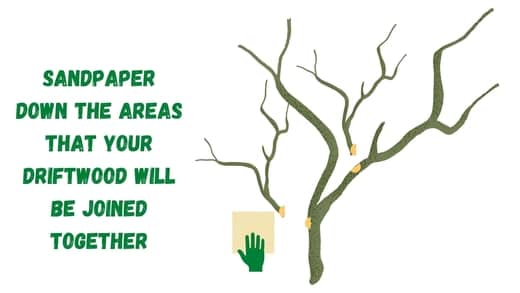
Join your driftwood pieces together to resemble a bonsai tree using screws or epoxy.
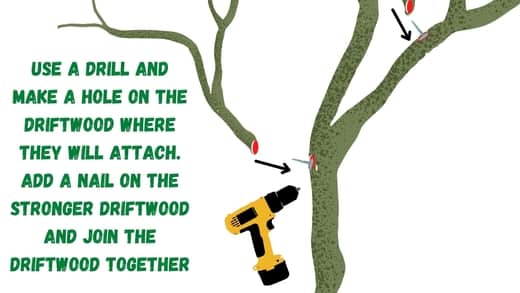
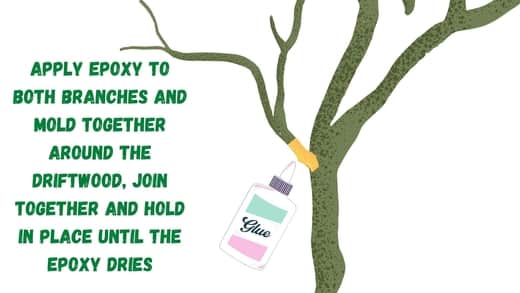
Create the leave using algae, moss, or underwater plants.

Soak your driftwood for 48 hours to ensure the driftwood sinks in your aquarium.
How to grow Aqua bonsai?
So growing aqua bonsai is a much more complicated process.
This is mainly because the best practitioners of hydroponic bonsai like to keep their methods as secret as possible.
The general gist, however, of aqua bonsai is as follows.
Remove your bonsai from its existing pot – ensuring that the bonsai tree is as small as possible.
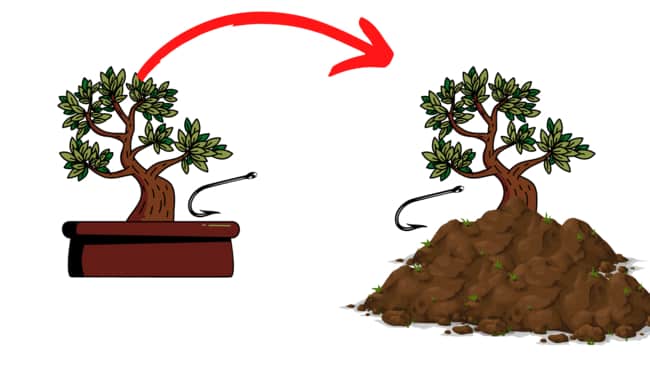
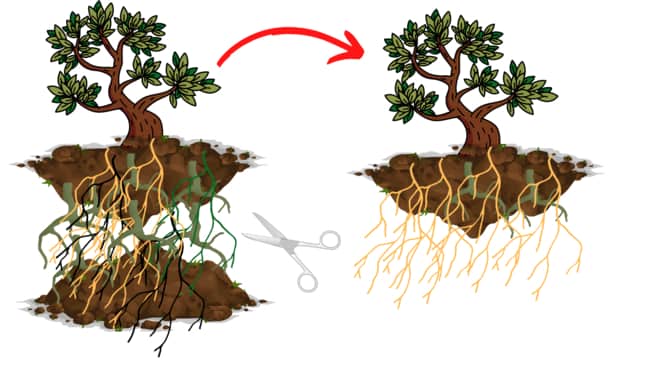
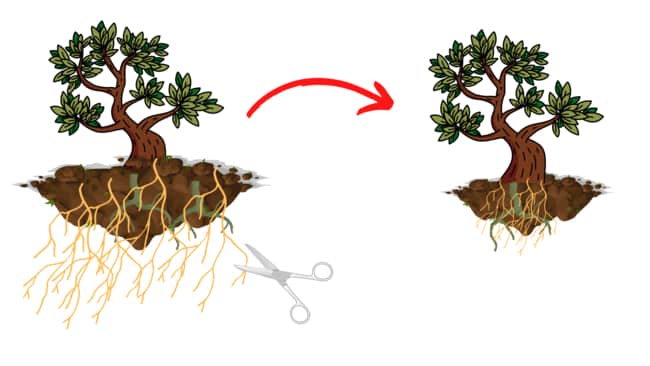
Smaller bonsai trees work best for this process.
Remove the soil and wash the roots of the bonsai.
It would be best if you placed the bonsai tree in a shallow pool of water for a few days – consider a bathtub.
When in the bathtub, you must provide bright artificial light with a full-color spectrum and a way to circulate the water in your bathtub regularly.
Once the new roots form, place them in a clear glass container.
Fill the glass container with water that is around 250ml and place one to two drops of liquid fertilizer once per week.
Regularly change out the water once per week.
Avoid using tap water for this method and instead opt for rain or filtered water which works best.
Aqua bonsai prefer a very slight acidic tinge to their water when growing, which the fertilizer should add.
Is growing aqua bonsai easy?
Growing aqua bonsai as a beginner is incredibly difficult.
The exact process of growing aqua bonsai successfully is held by a select few people who have yet to be willing to divulge their secrets.
Trying to grow an aqua bonsai without any guidance or specialty help is more challenging.
As such, I recommend growing an aqua bonsai until you have at least five years of experience growing multiple bonsai trees.
Can aqua bonsai grow in fish tanks or aquariums?
Aqua bonsai typically are not suited to growing in fish tanks or aquariums. This is because the amount of water these contain is usually far more significant than the limited amount of water aqua bonsai need.
The water aqua bonsai use also needs to be regularly changed, once weekly, making it much more difficult in large-scale aquariums.
Why do people grow underwater bonsai?
People mainly grow underwater bonsai trees to make their underwater space, such as an aquarium, more aesthetically pleasing.
People may also try to grow bonsai underwater as they need more space.
Finally, people may opt to grow aqua bonsai using the hydroponic method to test themselves in the art of bonsai as it is a very advanced method of bonsai growing.
Can bonsai trees live in fish tanks?
Faux bonsai trees made up of driftwood and mosses to resemble bonsai trees can be placed in a fish tank. Placing regular bonsai trees underwater in a fish tank will kill the tree if left for more than a few days.
Can bonsai live in just water?
Bonsai trees can live in water using the hydroponic or aqua bonsai method. In this method, bonsai trees are treated to grow new roots underwater. The bonsai is then placed in a small glass container, filled with water with fertilizer, and left to grow.
For best results, move the bonsai into a bright sunny spot and change the water and fertilizer weekly.
Can bonsai trees live underwater – survey results?
Finally, I wanted to ask 20 plant paladin raiders who own bonsai trees if bonsai trees can live underwater.
To summarize:

My top picks for the gear you will need!
So like I mentioned earlier, over the past three years of running PlantPaladin, hundreds of people have asked me for my recommendations on the best bonsai gear on the market.
Having spent thousands of dollars on bonsai items these past few years and tested at least 100 bonsai-specific products, I’ve listed my favorite products below – All of which I highly recommend and think you can get great value.
They can purchase directly by clicking the link to take them to Amazon.
Bonsai Tool Set: One of the significant challenges I’ve had is finding a toolset that was not only durable but didn’t break the bank. SOLIGT has recently developed a fantastic bonsai tool set that covers all the tools you need to trim, prune, and repot your trees. – You can grab it here.
Complete Bonsai Set: Many of you will want to grow your bonsai trees entirely from scratch, but finding the varicose seeds, pots, and other items in one place can be challenging. Leaves and Sole then have created a complete bonsai set that I’ve personally used that ticks all the boxes. You can grab it here.
Bonsai wire: The number of times I’ve run out of wire for my bonsai or purchased cheap bonsai wire that doesn’t do the job is embarrassing for me to admit. After a lot of trial and error, I found that using Hotop’s aluminum bonsai wire is one of the best options on the market. This can easily be used for both indoor and outdoor bonsai. You can grab it here.
This post was written by Fehed Nicass, who has been passionate about bonsai and gardening for over three years.
